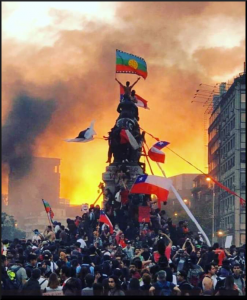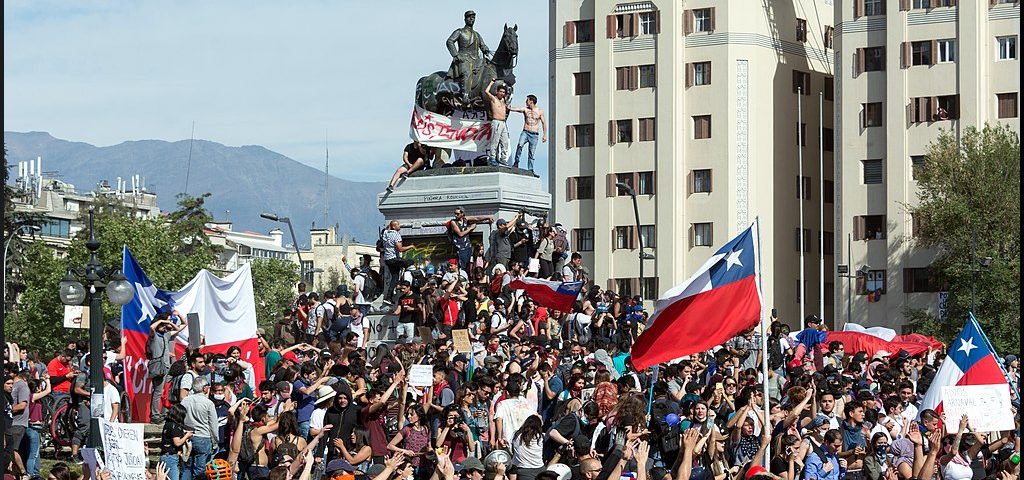By Lazaro Monteverde, Reporting for Socialist Action from Valparaiso, Chile, November 6, 2019
It started small. In the week of Monday, October 14 small groups of middle-school and high-school students started to jump the turnstiles and barriers at Santiago metro stations to protest a 30 peso (approximately 4 cents US) hike. The rate hike took place on October 6 and while it did not affect their fares, it was going to have a serious impact on their parents who also take the metro. In a country where 50% of the people earn less than $550 US dollars a month and where many prices are equal or almost equal to those in the US, the protests grew rapidly. Police tried to repress the protests on Thursday, October 17. In response, on Friday, October 18, students and parents sat down on the edge of the train platforms with their legs dangling over the edges. The train drivers refused to endanger the safety of either the protestors or their passengers. The 137 metro stations in Santiago were shut down. When police tried to clear the students using force, a minority of the protestors turned violent. Chilean President Sebastian Pinera declared a state of emergency, calling out the army to maintain order and instituting a curfew in the capital city. Then all hell broke loose.
 The state of emergency and curfew provoked widespread protest. Spontaneous demonstrations formed throughout the capital, with many people banging pots and pans in a typical Chilean form of protest which developed during the dictatorship. In addition to the large protests, which were met with tear gas and water cannons, small groups started setting fires to the metro stations or businesses. Others started to loot and rob grocery stores and pharmacies. The next day, Saturday October 19, the protests expanded to Valparaiso, Chile’s second city and the home to a large and radical working class. These peaceful protests were also repressed. Police started firing shots into the air and using rubber bullets, in addition to tear gas and water cannons. Protestors in Valpo, as the city is affectionately known by its inhabitants, burned a metro station (the metropolitan area of Valparaiso-Vina del Mar also has a metro line), the building housing El Mercurio of Valparaiso, and cars. On Sunday, Monday, and Tuesday, October 21, 21, and 22 respectively, protests and violence spread to all parts of the country. The state of emergency was extended to all areas with differing curfews imposed. Valparaiso was the last area to have a curfew.
The state of emergency and curfew provoked widespread protest. Spontaneous demonstrations formed throughout the capital, with many people banging pots and pans in a typical Chilean form of protest which developed during the dictatorship. In addition to the large protests, which were met with tear gas and water cannons, small groups started setting fires to the metro stations or businesses. Others started to loot and rob grocery stores and pharmacies. The next day, Saturday October 19, the protests expanded to Valparaiso, Chile’s second city and the home to a large and radical working class. These peaceful protests were also repressed. Police started firing shots into the air and using rubber bullets, in addition to tear gas and water cannons. Protestors in Valpo, as the city is affectionately known by its inhabitants, burned a metro station (the metropolitan area of Valparaiso-Vina del Mar also has a metro line), the building housing El Mercurio of Valparaiso, and cars. On Sunday, Monday, and Tuesday, October 21, 21, and 22 respectively, protests and violence spread to all parts of the country. The state of emergency was extended to all areas with differing curfews imposed. Valparaiso was the last area to have a curfew.
After the outburst of protest and violence on the 20th through the 22nd, protests became increasingly massive and peaceful. The culmination was a protest of 1.2 million people, according to official estimates, in Santiago on Friday, October 25. This was the largest protest in Chilean history, and as the Chilean media pointed out, the official estimates of protests usually cut the real attendance in half. Independent estimates placed the number at almost 2 million in a city of 6.7 million people. Similar large peaceful protests occurred in many other cities. The next day, Saturday, the curfew was lifted nationwide. On Sunday, October 27, 100,000 protest in the Valparaiso-Vina del Mar metropolitan area, with a large march coming from the hills of Valparaiso and another marching along the Pacific from Vina del Mar. The peaceful protests were incredibly diverse, with people of all ages and backgrounds. All were ultimately met by soldiers and police using teargas and water cannons. Demonstrations and protests, with some occasional violence have continued but diminished since the highpoint of protest on the weekend of Friday, October 26 to Sunday, October 27.
Pinera apologized to the Chilean people, replaced eight people in his 24-person cabinet, and rushed through measures reversing the fare increase and cutting utility rates. He also proposed a set of more substantial measures to address the protestors demands (see below). These reform measures, including a call for a constituent assembly to write a new constitution, are now bogged down in the Chilean congress.
Capitalism: The root cause
The fare hikes themselves were merely the straw that broke the camel’s back. The root cause, as many of the protestors clearly pointed out, was a capitalist system that had been imposed under the Pinochet dictatorship (1973-1990) and left untouched by past democratically elected governments (some from the Socialist Party) for the past 29 years. This neoliberal model which is now found throughout Latin America favors the rich with low taxes and little regulation while it privatizes most social services and taxes workers with regressive fees and taxes. In Chile, the top 1% own 33% of all the wealth in the country.

“Chili en lutte” by Airelle.info is licensed under CC BY-NC-ND 2.0
Chile is considered a developed country and has the highest per capita GDP in Latin America, at $26,667 (USD). It is also the most unequal developed country in the world, with a Gini Coefficient of .50. Of the ten most unequal countries in the world, Chile is number 7. Eight of the ten countries with the greatest income inequality in the world are in Latin America. All are characterized by a neoliberal capitalist model imposed by the US and international financial institutions such as the IMF. The per capita GDP is highly deceptive in a country where half the population make $6,60 a year, there is no social safety net, and an apartment in Santiago costs as much as an apartment in Brooklyn or Queens.
The Protestors’ Demands
The Chilean masses raised several related demands, all attacking the neoliberal state. These demands include:
- A new Chilean constitution—the current Chilean constitution, while it has been tinkered with since the transition to democracy is essentially the constitution that was written by Pinochet and his advisors before the transition. The constitution has a number of undemocratic features and ensures that the wealthy and the political rightwing have a significant share in the upper and lower chambers. In 2006 there was an effort to revise the constitution, but that effort was thwarted by the ruling class.
- A change in the pension fund—under Pinochet, the social security system was converted to a private pension fund system. All workers are required to pay into a private pension fund administered by for-profit entities. These funds charge user fees and have failed to produce pensions that people can live on. Many people, after paying into the funds for decades have little to show for it. Meanwhile, the shareholders of the funds make fat profits.
- A change in the education system—Pinochet also destroyed the teachers’ unions and created a three-tier education system. There are elite, high quality schools for the rich (these have always existed in Chile), there are for-profit schools similar to charter schools in the US that receive a government subsidy for each student but the parents also have to pay for these schools which can be very expensive for a middle class family. Finally, there are public schools which by all reports are overcrowded and of very poor quality after years of underfunding.
- Reduction of fees for basic services—many of the basic services in Chile were privatized under Pinochet. Electric power, water, and sanitation are all controlled by lightly regulated corporations, many of them transnationals. Chile has faced a number of water crisis similar to the Flint water crisis in the US—contaminated water unfit for human consumption. The rate hike in Metro fares is one example of these fees for basic services.
- An end to corruption in business and politics, and a reduction in the salaries of members of congress—Political corruption scandals are common in Chile, as is insider trading. The members of congress make many times what the average Chile makes.
- A change in the health care system—Chile has a private health care system in many ways similar to the US. While prices are lower here than in the US, drug and medical costs are very high compared to most people’s wages, insurance is expensive and does not cover what it should, and people often have to wait months to see a doctor or to have a medical procedure performed.
- A reduction in the work week to 40 hours and a guaranteed minimum income—This is not a demand for a minimum wage, but for a minimum income where if your salary falls below a certain minimum, the government would pay you the difference.
- A change in the tax system—Chile has low taxes on the rich who often avoid paying taxes altogether while the middle and working class suffer under a regressive and burdensome tax structure. Taxing the 1% and making sure that they actually pay would provide the Chilean government with much of the revenues needed for the social safety net.
In short, the Chilean masses are demanding a new government and a new social pact. While the Pinera government and congress has made some small steps, such as rescinding the metro fare hike and proposing to add government money to the pension funds to augment the benefits the elderly receive, most Chileans see these steps as too little and too late. Approval of Pinera has dropped to 18% in the most recent polls and many are calling for his resignation. Will the protests continue? The answer to this question depends on the actions of the ruling political elite and the decisions of the Chilean masses. As the Chilean novelist Isabel Allende wrote at the end of October: “This is the way revolutions start.”
*Featured Image:Protest in Chile, October 22, 2019, Plaza Baquedano, Santiago, Chile ~Carlos Figueroa
